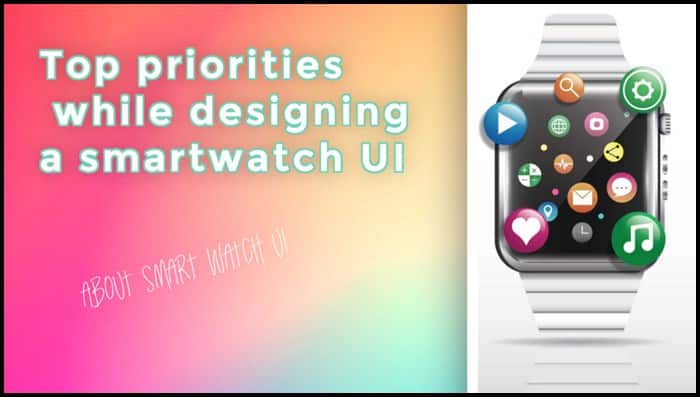In the last couple of years, the demand for smartwatches has increased rapidly, elevating the competition among companies to design better products than the other. Today we not only can see the time on these watches but also receive calls, notifications, talk to people, take photos, measure body temperature, blood pressure, oxygen level, count steps, and much more with the tech on our wrists.
The smartwatch UI design affects its quality and the experience of using it. Some of the best smartwatches are made by Apple and Samsung. They currently provide the best user experience, although other companies are rapidly improving their smartwatch UX.
While designing a smartwatch UI, some points need to be prioritized over others to deliver the best user experience. They are listed below.
Smartwatch UI design priorities
1. Screen Size:
The main aspect to consider before designing UI for a smartwatch is the display size the target watch would provide. The apps should be customized based on the screen size such that everything doesn’t get crammed within a small space.
Some watches come with a circular dial, while others come in a rectangular or square one. There are so many options that designers find it critical to customize the UI for different shapes and sizes. Also, the display resolution matters a lot so that everything looks clear through that tiny screen.
2. Ease of Interaction:
The UI design should focus on how smoothly an average user can navigate different apps. Gestures and voice commands are best fitted in this case. Simple gesture navigations like swipe or touch are the most efficient ways to save screen space while making it easy to operate. Use larger icons so that the user doesn’t often miss touch and open the wrong apps.
3. At a Glance:
Lesser the unnecessary clutter on the screen, the better. Smartwatches are meant to notify the user on the go so that while walking or doing work, they don’t need to stop and read long texts or notifications.
A minimalistic and aesthetic UI is appealing for everyone. The screen color and contrast should be set in such a way that it isn’t difficult to glance at notifications in the bright daylight or night.
4. Applications:
A smartwatch’s performance and user experience depend significantly on the number of apps and their usage. Do not overstuff the watch with too many apps, or it would make it slow. The apps should be minimalistic and able to satisfy the needs of the users. Also, use a black background on every apps and menu because it helps to save more battery.
The smartphone application connected to the watch should also follow these tips because an easy-to-use application with a simple UI will be preferred to anything else.
5. Notifications and Alerts:
Make the notification alerts simple and show only the part a user wants to see. If the user receives a text notification, show which app it came from and who sent it. You can add a feature here which will show the user the first few lines of the message on tapping the notification.
Also, make a filter for apps that will be allowed to send notifications to the smartwatch. No one would like their watch to keep on vibrating on their wrist by all the spam notifications.
The alert haptics shouldn’t be annoying, and different alert methods should be provided to the user, like screen flash or watch vibration. People who don’t like the vibration feature can easily switch to screen flash and vice versa.
6. Enhance the features:
Every smartwatch out there displays the time or shows notifications, so what makes yours stand out? Think of ways to make the user’s life easier, not miserable. Like, remind the user of important meetings, or show them the restaurant’s menu they are going to.
Read More : 7 Different Types of Watches That You Can Own
7. Longer Battery life:
This is a crucial aspect for a better User Experience as no one wants their watch to turn off while they’re outside. Modern smartwatches have more than 10 days of battery life. The battery life heavily depends on the UI design, as a complex UI design would require the user to spend more time operating the watch to do simple tasks.
But why use a smartwatch when a smartphone can do it all?
This is a common misconception among a lot of people regarding the use of smartwatches. Yes, smartphones can do everything and much more than what modern smartwatches can do, but the problem lies there.
The multi-functionality of smartphones often distracts us during work; e.g., sometimes we take out our phone from the pocket for responding to a call but end up checking texts after that.
A smartwatch can deliver notifications, and we can deal with them based on their priority, and we don’t need to take out our phones to check whether we want to respond or not. So, snap out of your misconception.
Final Words
It is essential to test and retest the builds for making the perfect UI while regularly adding and testing more features or optimizing the already present ones.
A good UI design can make a smartwatch popular among the target audience if it properly addresses their problems. It is always important to build UIs based on the needs of the user and not the developer. So, keeping the above points in mind, start making your smartwatch UI designs today.

Leave a Reply
You must be logged in to post a comment.